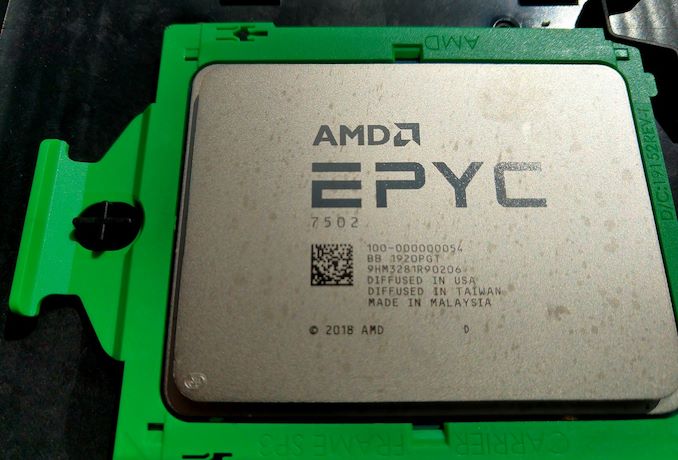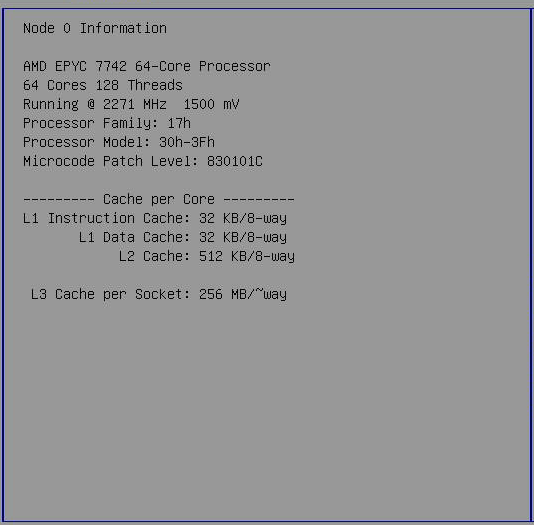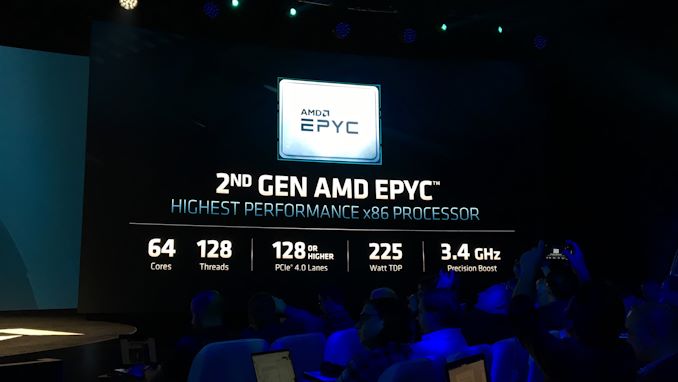AMD Rome Second Generation EPYC Review: 2x 64-core Benchmarked
by Johan De Gelas on August 7, 2019 7:00 PM EST
If you examine the CPU industry and ask where the big money is, you have to look at the server and datacenter market. Ever since the Opteron days, AMD's market share has been rounded to zero percent, and with its first generation of EPYC processors using its new Zen microarchitecture, that number skipped up a small handful of points, but everyone has been waiting with bated breath for the second swing at the ball. AMD's Rome platform solves the concerns that first gen Naples had, plus this CPU family is designed to do many things: a new CPU microarchitecture on 7nm, offer up to 64 cores, offer 128 lanes of PCIe 4.0, offer 8 memory channels, and offer a unified memory architecture based on chiplets. Today marks the launch of Rome, and we have some of our own data to share on its performance.
Review edited by Dr. Ian Cutress
First Boot
Sixty-four cores. Each core with an improved Zen 2 core, offering ~15% better IPC performance than Naples (as tested in our consumer CPU review), and doubled AVX2/FP performance. The chip has a total of 256 MB of L3 cache, and 128 PCIe 4.0 lanes. AMD's second generation EPYC, in this case the EPYC 7742, is a behemoth.
Boot to BIOS, check the node information.
[Note: That 1500 mV reading in the screenshot is the same reading we see on consumer Ryzen platforms; it seems to be the non-DVFS voltage as listed in the firmware, but isn't actually observed]
It is clear that the raw specifications of our new Rome CPU is some of the most impressive on the market. The question then goes to whether or not this is the the new fastest server chip on the market - a claim that AMD is putting all its weight behind. If this is the new fastest CPU on the market, the question then becomes 'by how much?', and 'how much does it cost?'.
I have been covering server CPUs since the launch of the Opteron in 2003, but this is nothing like I have seen before: a competitive core and twice as much of them on a chip than what the competition (Intel, Cavium, even IBM) can offer. To quote AMD's SVP of its Enterprise division, Forrest Norrod:
"We designed this part to compete with Ice Lake, expecting to make some headway on single threaded performance. We did not expect to be facing re-warmed Skylake instead. This is going to be one of the highlights of our careers"
Self-confidence is at all times high at AMD, and on paper it would appear to be warranted. The new Rome server CPUs have improved core IPC, a doubling of the core count at the high end, and it is using a new manufacturing process (7 nm) technology in one swoop. Typically we see a server company do one of those things at a time, not all three. It is indeed a big risk to take, and the potential to be exciting if everything falls into place.
To put this into perspective: promising up to 2x FP performance, 2x cores, and a new process technology would have sounded so odd a few years ago. At the tail end of the Opteron days, just 4-5 years ago, Intel's best CPUs were up to three times faster. At the time, there was little to no reason whatsoever to buy a server with AMD Opterons. Two years ago, EPYC got AMD back into the server market, but although the performance per dollar ratio was a lot better than Intel's, it was not a complete victory. Not only was AMD was still trailing in database performance and AVX/FP performance, but partners and OEMs were also reluctant to partner with the company without a proven product.
So now that AMD has proven its worth with Naples, and AMD promising more than double the deployed designs of Rome with a very quick ramp to customers, we have to compare the old to the new. For the launch of the new hardware, AMD provided us with a dual EPYC 7742 system from Quanta, featuring two 64-core CPUs.












180 Comments
View All Comments
schujj07 - Friday, August 9, 2019 - link
The problem is Microsoft went to the Oracle model of licensing for Server 2016/19. That means that you have to license EVERY CPU core it can be run on. Even if you create a VM with only 8 cores, those 8 cores won't always be running on the same cores of the CPU. That is where Rome hurts the pockets of people. You would pay $10k/instance of Server Standard on a single dual 64 core host or $65k/host for Server DataCenter on a dual 64 core host.browned - Saturday, August 10, 2019 - link
We are currently a small MS shop, VMWare with 8 sockets licensed, Windows Datacenter License. 4 Hosts, 2 x 8 core due to Windows Licensing limits. But we are running 120+ majority Windows systems on those hosts.I see our future with 4 x 16 core systems, unless our CPU requirements grow, in which case we could look at 3 x 48 or 2 x 64 core or 4 x 24 core and buy another lot of datacenter licenses. Because we already have 64 cores licensed the uplift to 96 or 128 is not something we would worry about.
We would also get a benefit from only using 2, 3, or 4 of our 8 VMWare socket licenses. We could them implement a better DR system, or use those licenses at another site that currently use Robo licenses.
jgraham11 - Thursday, August 8, 2019 - link
so how does it work with hyper threaded CPUs? And what if the server owner decides to not run Intel Hyperthreading because it is so prone to CPU exploits (most 10 yrs+ old). Does Google still pay for those cores??ianisiam - Thursday, August 8, 2019 - link
You only pay for physical cores, not logical.twotwotwo - Thursday, August 8, 2019 - link
Sort of a fun thing there is that in the past you've had to buy more cores than you need sometimes: lower-end parts that had enough CPU oomph may not support all the RAM or I/O you want, or maybe some feature you wanted was absent or disabled. These seem to let you load up on RAM and I/O at even 8C or 16C (min. 1P or 2P configs).Of course, some CPU-bound apps can't take advantage of that, but in the right situation being able to build as lopsided a machine as you want might even help out the folks who pay by the core.
azfacea - Wednesday, August 7, 2019 - link
FNikosD - Wednesday, August 7, 2019 - link
Ok guys...The Anandtech's team had a "bad luck and timming issues" to offer a true and decent review of the Greatest x86 CPU of all time, so for a proper review of EPYC Rome coming from the most objective and capable site for servers, take a look here:https://www.servethehome.com/amd-epyc-7002-series-...
anactoraaron - Thursday, August 8, 2019 - link
Fphoenix_rizzen - Saturday, August 10, 2019 - link
Review article for new CPU devolves into Windows vs Linux pissing match, completely obscuring any interesting discussion about said hardware. We really haven't reached peak stupid on the internet yet. :(The Benjamins - Wednesday, August 7, 2019 - link
Can we get a C20 benchmark for the lulz?